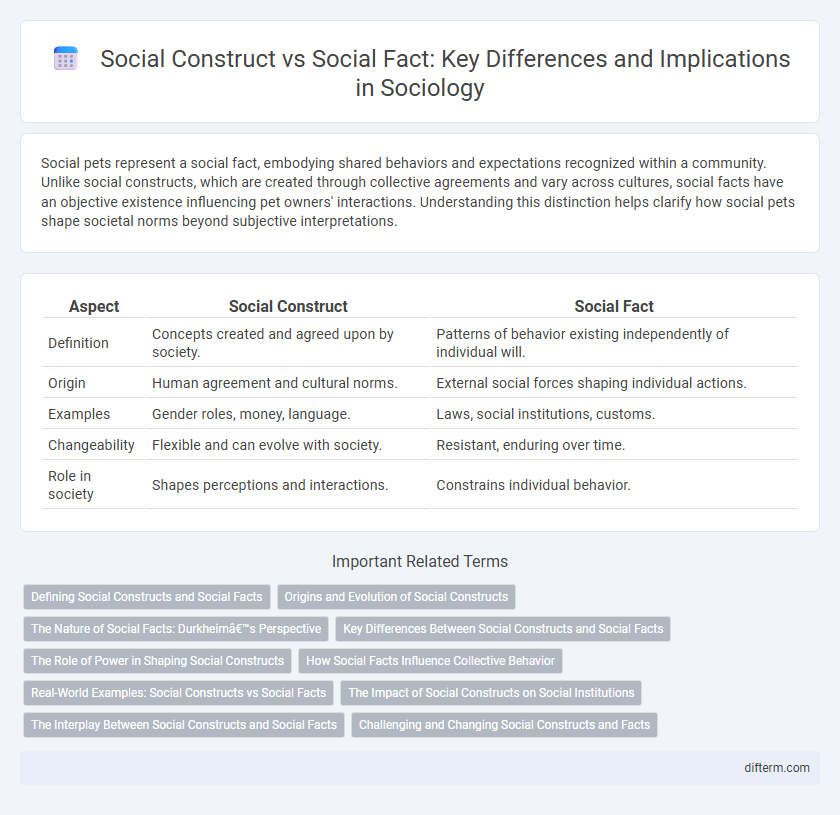Social pets represent a social fact, embodying shared behaviors and expectations recognized within a community. Unlike social constructs, which are created through collective agreements and vary across cultures, social facts have an objective existence influencing pet owners' interactions. Understanding this distinction helps clarify how social pets shape societal norms beyond subjective interpretations.
Table of Comparison
| Aspect | Social Construct | Social Fact |
|---|---|---|
| Definition | Concepts created and agreed upon by society. | Patterns of behavior existing independently of individual will. |
| Origin | Human agreement and cultural norms. | External social forces shaping individual actions. |
| Examples | Gender roles, money, language. | Laws, social institutions, customs. |
| Changeability | Flexible and can evolve with society. | Resistant, enduring over time. |
| Role in society | Shapes perceptions and interactions. | Constrains individual behavior. |
Defining Social Constructs and Social Facts
Social constructs are conceptions or perceptions created and maintained through collective human agreement, often varying across cultures and time periods. Social facts, as defined by Emile Durkheim, are external, coercive phenomena that exist independently of individual beliefs, such as laws, norms, and institutions. Understanding the distinction between socially constructed realities and objectively existing social facts is critical for analyzing societal behavior and organization.
Origins and Evolution of Social Constructs
Social constructs emerge from collective human agreement and shared cultural practices, evolving over time as societies reinterpret norms and values. Unlike social facts, which are objective realities external to individuals, social constructs are fluid and dynamic, shaped by historical context and power relations. Their origins lie in the need to organize complex social interactions, with evolution driven by changing economic, political, and technological conditions.
The Nature of Social Facts: Durkheim’s Perspective
Emile Durkheim defined social facts as patterns of behavior, thinking, and feeling external to the individual yet exerting coercive power. These social facts exist independently of individual consciousness and shape social order through norms, values, and laws. Durkheim emphasized that social constructs arise from collective consciousness, making social facts essential for maintaining societal cohesion and continuity.
Key Differences Between Social Constructs and Social Facts
Social constructs are ideas or concepts created and maintained by collective human agreement, such as money, gender roles, or marriage, whereas social facts are objective, external realities that influence individual behavior, like laws, customs, or institutions. Social constructs depend on human perception and consensus, while social facts exist independently and exert coercive power over individuals. Understanding these distinctions highlights how societies shape and regulate human interaction through both mutable ideas and enduring norms.
The Role of Power in Shaping Social Constructs
Power dynamics play a crucial role in shaping social constructs by influencing norms, values, and accepted behaviors within societies. These constructs, built through collective agreement, often reflect the interests of dominant groups, embedding inequalities into social facts that are perceived as objective realities. Understanding power's influence reveals how social facts maintain control and legitimize hierarchical structures over time.
How Social Facts Influence Collective Behavior
Social facts, as defined by Emile Durkheim, exert an external force on individuals, shaping collective behavior through established norms, values, and institutions that guide and constrain actions within society. These social constructs create predictable patterns by embedding themselves in social practices, influencing how groups interact, make decisions, and maintain social order. Understanding the power of social facts is crucial for analyzing social cohesion and the mechanisms behind collective responses to events.
Real-World Examples: Social Constructs vs Social Facts
Gender roles serve as a prime example of social constructs, shaped by cultural norms and varying significantly across societies and historical periods. Conversely, laws such as traffic regulations represent social facts, existing independently of individual beliefs and enforcing consistent patterns of behavior. Understanding the distinction between these allows for clearer analysis of societal dynamics and the influence of collective human agreement versus objective social realities.
The Impact of Social Constructs on Social Institutions
Social constructs shape social institutions by defining norms, roles, and expectations that influence behavior and organizational structure. These constructs, while intangible, manifest through laws, policies, and cultural practices that guide institutional operations and societal interactions. Understanding how social constructs affect institutions reveals the dynamic relationship between collective beliefs and systemic frameworks.
The Interplay Between Social Constructs and Social Facts
Social constructs shape collective perceptions and norms, influencing behaviors that become ingrained as social facts within society. These social facts, such as laws or moral codes, exert external pressure on individuals, reinforcing the constructed realities and sustaining social order. The dynamic interplay between social constructs and social facts reveals how societal consensus evolves and stabilizes shared meanings.
Challenging and Changing Social Constructs and Facts
Challenging and changing social constructs requires critical examination of ingrained beliefs that shape societal behaviors and norms, often revealing their malleable and culturally contingent nature. Social facts, understood as external and coercive forces influencing individual actions, can evolve through collective awareness and shifts in social institutions. Transformative social movements leverage this dynamic by questioning dominant paradigms and promoting new frameworks aligned with justice and equity.
social construct vs social fact Infographic

 difterm.com
difterm.com